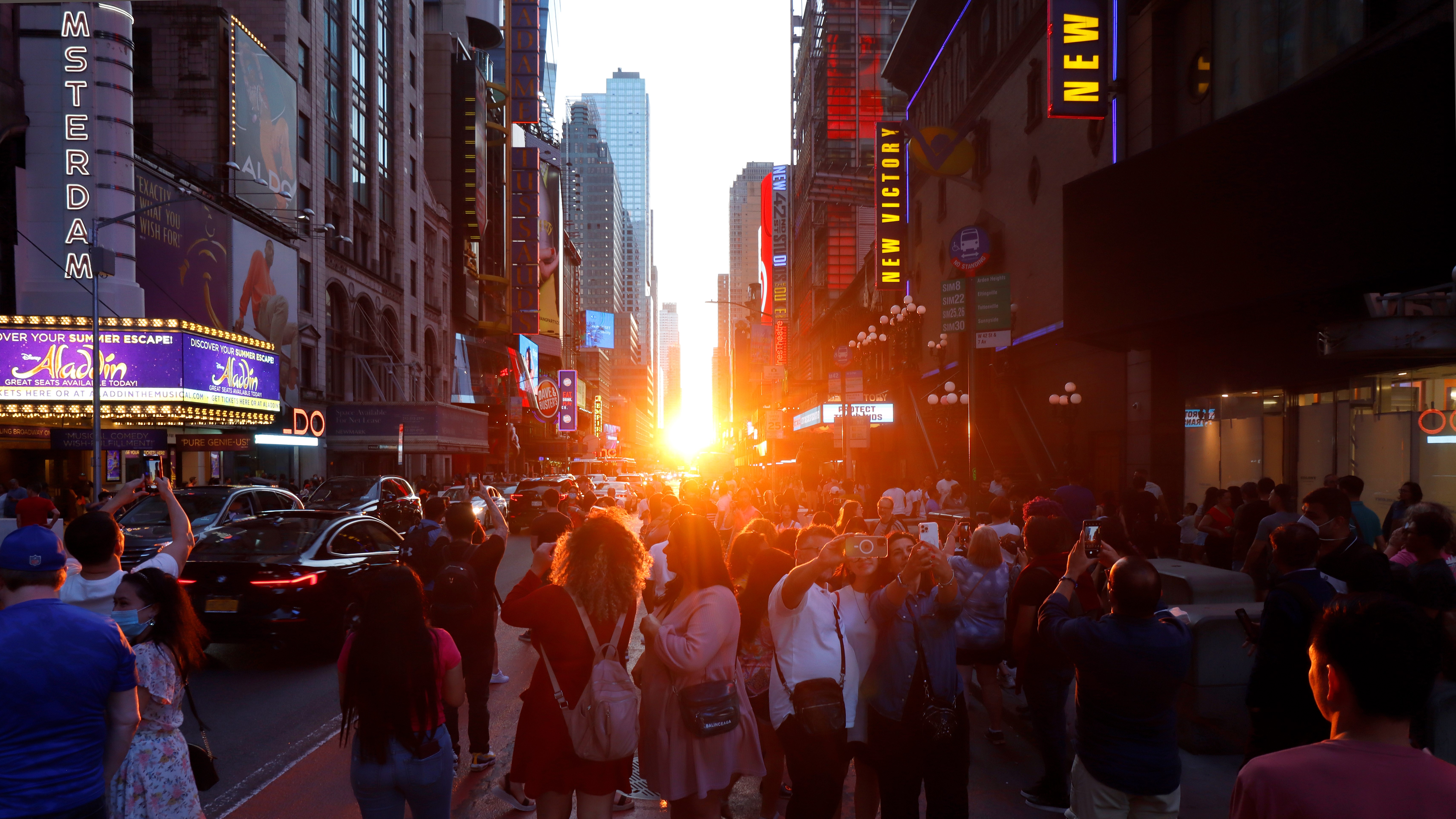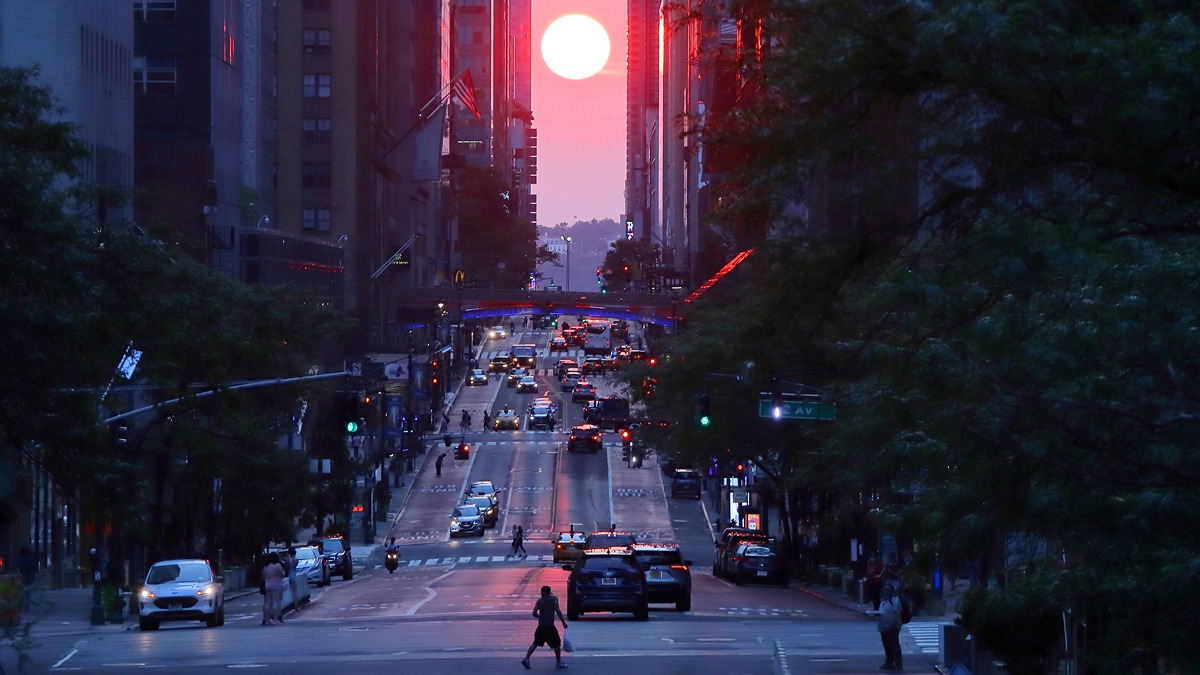Manhattanhenge: What makes New York City's iconic sunset so special?
Manhattanhenge, a phenomenon when the setting sun is perfectly aligned with Manhattan's grid-patterned streets, occurs twice a year with a full sunset, and twice a year with a half sunset.

In New York City, when the setting sun aligns perfectly with Manhattan's grid-patterned streets, it creates a picturesque effect where the north and south sides of the city's cross streets are basked in the sun's light.
The phenomenon, dubbed "Manhattanhenge," occurs twice a year with the full sun, and twice a year with the half sun, depending on weather conditions. The dates vary each year, but they typically fall in May and July. It happens four times on two paired dates at the end of May and mid-July; twice with the half-set sun lining up in the exact center of the "canyons" between buildings, and twice with the full circle of the sun touching down in alignment with the city grid.
During the full Manhattanhenge — as the setting sun lines up with the city streets — the entire orb appears on the horizon. With the half sunsets, as the name implies, half of the sun appears above the horizon, and the other half below.
"The reason we have Manhattanhenge is related to the way the Earth orbits the Sun and the island of Manhattan is shaped," Jackie Faherty, senior scientist & senior education manager at the American Museum of Natural History, told Live Science in an email. "Neither of those things changes much over the years so you will have the event occurring at almost the same time sequentially. The name was coined by the director of the Hayden Planetarium Neil deGrasse Tyson who was given an homage to Stonehenge."
How to see Manhattanhenge
The most spectacular Manhattanhenge displays occur at sunset, but spectators are advised to head outside about 30 minutes before to watch as the sun descends in the sky. Manhattanhenge's stunning visual impact is due in part to the expanse of the Hudson River and the relatively low buildings on the New Jersey shoreline, which make for an unobstructed view of the sun as it drops to the horizon in the west for "the grid kiss," Faherty said.
"For best effect, position yourself as far east in Manhattan as possible," Tyson wrote in a blog post on the Hayden Planetarium's website. "But ensure that when you look west across the avenues you can still see New Jersey."
Tyson suggests picking one of the wider cross streets to view Manhattanhenge, including 14th, 23rd, 34th, 42nd and 57th. Many of the streets immediately adjacent to these ones also offer nice places to watch the spectacle. "The Empire State Building and the Chrysler Building render 34th Street and 42nd Street especially striking vistas," Tyson said.
Get the world’s most fascinating discoveries delivered straight to your inbox.
Related: Where is Stonehenge, who built the prehistoric monument, and how?
Faherty said that the best way to see Manhattanhenge is to pick a street with a wide view with nothing obstructing it towards the Hudson. "There is quite a bit of topography in NYC where there will be little hills along a given cross street that will make it difficult to see straight toward NJ (New Jersey)," she said. "So I always tell people to scope out their favorite location a few days ahead of time and make sure there are no trees, no hills, and no tall buildings in NJ that would block the sun as it hits the horizon.
"Getting yourself settled about 20 minutes before sunset is ideal. Sometimes I leave myself even more time since I really love watching how the light on the horizon changes as the sun starts to set."
The nickname Manhattanhenge is derived from Stonehenge, a prehistoric monument that can be found north of the modern-day city of Salisbury, England. Once a year, the sunrise is perfectly aligned with the stone columns that make up this horseshoe-shaped megalith, which archaeologists believe was built around 2,500 B.C.
New York City is not the only place to experience these types of solstices. Other cities with straight east-west grid-patterned streets enjoy these dazzling sunsets as well, including Chicago and Baltimore in the United States, and Toronto in Canada.
Will Manhattanhenge always light up NYC streets?
Manhattanhenge's alignment only happens on certain dates because the exact position of the rising and setting sun on the horizon is slightly different every day — the result of Earth being tilted on its axis by 23.5 degrees in its orbital plane, Faherty said. But in addition to Manhattanhenge, the nearly setting sun is visible between the city's cross streets during a range of dates bracketing the summer solstice, with the so-called "Manhattanhenge Effect" lasting from the first sunset grid kiss in May until the last one in July.
Between May 29 and the summer solstice, the sun is still visible at the center of the city's cross streets, hitting the "sweet spot" just a little higher each day. After the summer solstice (which normally takes place between June 20 and 22) "when the Northern Hemisphere starts to tilt away from the sun," the same thing happens in reverse, with the sun hitting the center of the grid a little lower each day "until the second grid kiss in July, when it's the last time the sun makes it that far north," Faherty said.
However, if Earth were to suddenly tip over even farther on its axis — perhaps following a massive cosmic collision — that would jar the alignment enough to end Manhattanhenge forever. "It would have to knock us pretty far, though, for it to not happen in Manhattan at all," Faherty said.

Such a devastating impact would cause a host of more immediate concerns than the loss of Manhattanhenge. But luckily, the chances of such an Earth-changing event actually taking place are pretty slim, she said.
"Earth is pretty stable in its orbit, so as far as current humanity goes, we're not losing that anytime soon. No one who's reading this is going to lose the grid kiss unless something catastrophic happens to the Earth, and I don't see anything like that on the horizon."

Denise Chow was the assistant managing editor at Live Science before moving to NBC News as a science reporter, where she focuses on general science and climate change. Before joining the Live Science team in 2013, she spent two years as a staff writer for Space.com, writing about rocket launches and covering NASA's final three space shuttle missions. A Canadian transplant, Denise has a bachelor's degree from the University of Toronto, and a master's degree in journalism from New York University.
- Mindy WeisbergerLive Science Contributor


